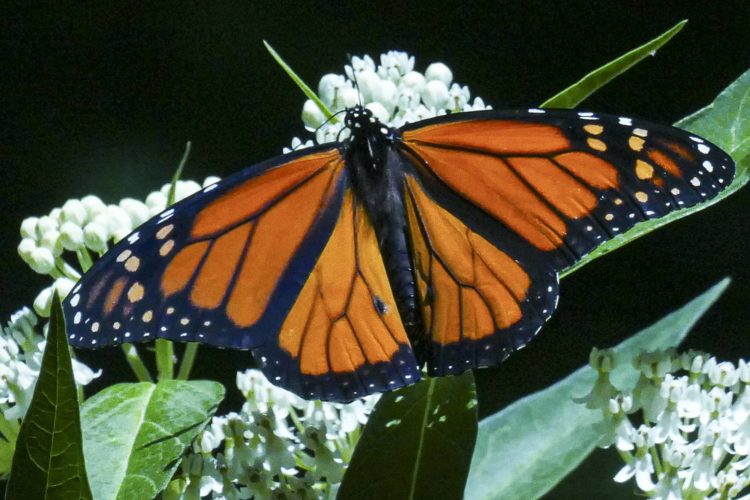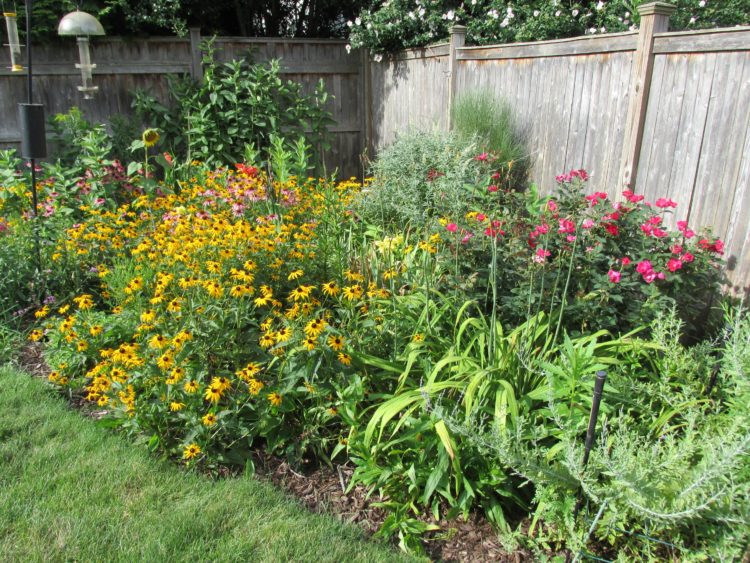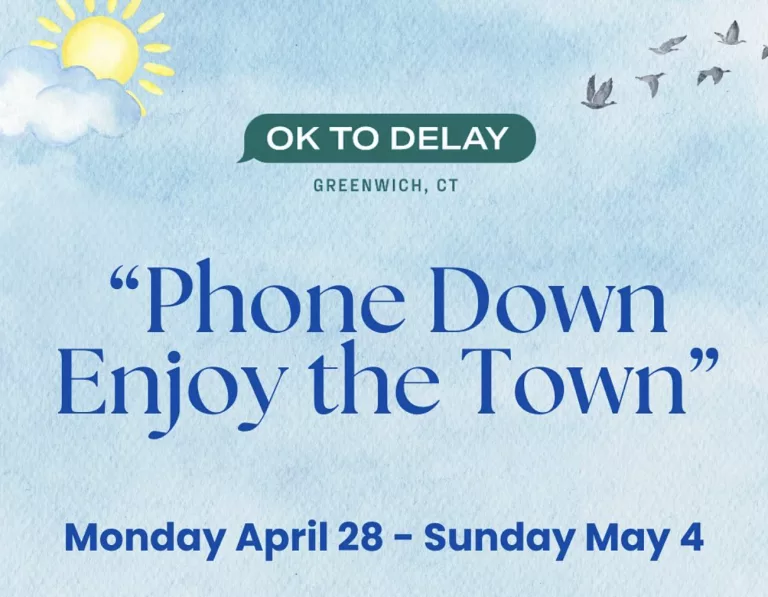
By Anne W. Semmes
It’s shocking and saddening to learn our beloved, brave, and beautiful monarch butterfly is now an endangered species so deemed by the International Union for Conservation of Nature (IUCN), having dramatically decreased over the past decade. I’d seen them in their orange glory last September on a street near Byram Park on a clump of purple asters. I was looking forward to their return.
The dire list of reasons for their decline I read in a World Wildlife Fund report. After their great 2,500-mile multi-generation migration back to their wintering site in Mexico they face now only five acres of forest coverage compared to 45-acres in the late 1990’s. Can’t anyone stop that illegal logging of their safe forest haven?
It was time to head to Audubon Greenwich to learn the local state of our monarchs from naturalist Ryan MacLean with his 20-year presence at Audubon, the last nine on staff. He reported, “a very low number of monarchs that we’ve seen on our property…These are the offspring of the ones that have come up from Mexico this year.”
But Ryan surprised with his astounding monarch counts as of last fall – as Audubon’s annual hawk watch has also counted monarchs. “Last Fall of 2021 we actually had a day total of 691 monarch butterflies on September 19th…our highest ever total counted here. The season total for the duration of the hawk watch season last year was 1,469 Monarchs. This was a major improvement from an entire season total of 148 in 2016.
“But these monarchs of course were none of the butterflies that are returning here in the spring so something clearly must have happened between last fall and now. Why this has become such a hemispheric issue is where they are going through when they’ve got to migrate through the Midwest, or the southern United States, to the Gulf of Mexico. Probably a lot of stopover points are farms in the Midwest using pesticides…eliminating milkweed. And if those [plants] aren’t there for them, then they don’t have the necessary energy to get from one place to another. And catastrophic weather events can also greatly affect both when they come back up here and when they’re going down. Another one is the effects of climate. And if it’s during hurricane season, that can be very problematic for them, too.”
Ryan then walked me through some of Audubon’s native pollinator flowers awaiting those feeding-up monarchs preparing to migrate. He pointed out joe pye weed, butterfly weed, and dogbane. “Just one of these patches of flowers someone could put in their front yard,” he told. “It doesn’t take a whole 300-acre nature reserve. Every little bit helps in every yard. That can be the entire basis for recovery. The worst thing for them is if they just see bare lawn, heavily manicured with pesticides or herbicides.”
Ryan shows me the all-important milkweed planted close to the Center. “Here’s one stalk of milkweed and you can see some bite marks out of it, which may be a monarch caterpillar was there…So, all that the monarchs are coming to do now is the female may be coming to a leaf here, to deposit an egg…and the caterpillars obviously hatch from the leaf.”
So, concerning that all-important need to provide these diminishing monarchs their necessary plants, I was happy to learn of the nationwide Monarch Waystation Program, from Sentinel columnist Jim Knox, the Curator of Education at Connecticut’s Beardsley Zoo in Bridgeport. His Zoo is a Monarch Waystation. “They can use all the help we can give them,” he shared.

So, as of this July 2022, found on their website, there are 39,570 Monarch Waystation habitats registered nationwide. We have former First Lady Rosalynn Carter to thank for these Waystations. Seeing the decrease of monarchs in her home state of Georgia some 30 years ago she spearheaded an effort to increase the number of butterfly gardens in her state, an effort now grown to nearly 40,000 Waystations across the country, of which ten are in Greenwich!
The ten include five residential Waystation butterfly gardens, and five public Waystations including the Old Greenwich Garden Club Butterfly Garden at Greenwich Point, Riverside Elementary School, Julian Curtiss Elementary School, Town Hall Annex Hillside Garden, and Pocket Park, Greenwich Close Apartments.
The Old Greenwich Garden Club Butterfly Garden Waystation overlooks Eagle Pond at the old Tod Mansion site. Jan Linsky co-chairs the Waystation, registered in 2015. It features over 40 species of plants she shared. “What we’re trying to do is plant plants for both the butterfly larva and also for the adults.” They’ve found monarch larva on the milkweed, but are not seeing monarchs. “The monarch numbers are way down.”
She recalled being thrilled last August and September at seeing the number of monarchs migrating. She’s hoping the same will be for this fall. “But it’s disappointing we’ve seen so few.” She’s also noted a drop in the number of bird species. “Is it global warming,” she asked, “or is it because everybody sprays their backyard and there’s no mosquitoes.”
But in Riverside there is a most enterprising woman who has created a veritable Shangri-la for monarch butterflies in her suburban backyard. Diana Klingner, known for her fight against invasives on Greenwich Point as board member of the Friends of Greenwich Point registered her Riverside garden as a Monarch Waystation in 2017. And over four years she has brought to life some 500 monarch butterflies – through her husbandry.
“I planted that milkweed,” she shared, “and I was waiting to find the caterpillars and the chrysalises – nothing happened. The next year I decided to start taking the eggs inside. When I find the eggs on the leaves, I take them in and I raise them in my house.” And when they become butterflies she releases them. This husbandry came about having only found a total of 30 live caterpillars on her milkweed, “meaning as soon as they hatch,” she told, “the tiny caterpillars get eaten right away.”
And those major predators Diana opines are “ants, spiders, and wasps” stealing her baby “cats” (caterpillars). She’s also learned, “The monarchs like to lay their eggs down deep in the milkweed because it’s cooler down there, and it’s hidden from predators.” And they prefer single plants, “Because if they lay their eggs in the grove, there’s more predators hanging out waiting.”
Diana is presently passing on her monarch husbandry to two neighbors, Crosby, age six and a half, and brother Cameron, three and a half. They are into their second year of raising monarchs. This week they came with their “cage” for their two gifted caterpillars each. They’re instructed to take a milkweed leaf off their reserved plant to feed their caterpillars and will watch them climb to the top of the “cage” and become chrysalises, then butterflies. “And the fun thing for them [last year],” said Diana, “was when they put the butterflies on their fingers and let them go.”
For information on the Monarch Waystation Program, visit https://www.monarchwatch.org/waystations/monarch_waystation_brochure.pdf. To see a list of plant species to plant for monarchs visit https://www.monarchwatch.org/garden/plant-list-monarchwatch.pdf





